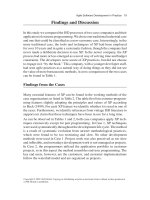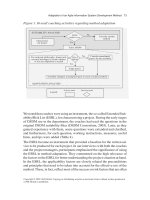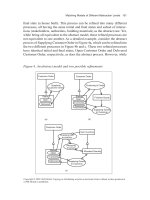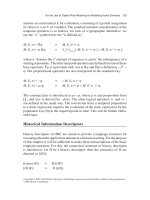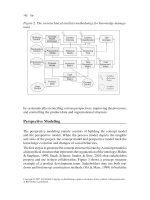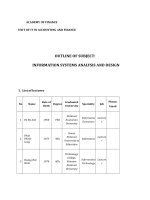Systems analysis and development CIS210 ch 07
Bạn đang xem bản rút gọn của tài liệu. Xem và tải ngay bản đầy đủ của tài liệu tại đây (1.24 MB, 12 trang )
CIS 210
Systems Analysis
and Development
Week 4 Part I
Structuring System
Process Requirements
Objectives
• Upon completion of part I you will be able to:
– Understand and be able to explain the concepts related to the
logical modeling process
– Understand and be able to draw data flow diagrams
– Understand and be able to decompose data flow diagrams
into lower-level diagrams
– Understand and be able to balance higher-level and lowerlevel data flow diagrams
– Understand and be able to explain the concepts related to the
differences between the four types of DFDs
– Understand and be able to explain the concepts related to
Oracle’s process modeling tool and with functional hierarchy
diagrams
Overview
• Data Flow Diagrams
–
–
–
–
Model data flow
Data flow relationships
Change processes
Also called process models
Process Modeling
• Overview
– Data flow diagram is common form
• Modeling a Systems Process for Structured Analysis
– Analysis team
– Organization of information
• Deliverables and outcomes
–
–
–
–
–
Context diagram
Diagrams of current system
Logical data flow diagrams
Data flow and functional requirements
Entries of all objects in project dictionary
Diagramming
Mechanics
Diagramming
Mechanics
Diagramming
Mechanics
• Decomposition of DFDs
–
–
–
–
–
From one system to multiple systems
Functional decomposition
Iterative process
Finer and finer detail
Primitive DFD
• Balancing DFDs
– Balancing inputs and outputs
Types of DFDs
• Current Physical
– People’s names
– Positions
• Current Logical
– Current system reduced to its essence
– Data and processes
• New Logical
– Additional functions
– Obsolete functions removed
• New Physical
– Automated and manual functions
Using Data Flow
Diagramming in Analysis
• DFD Guidelines
–
–
–
–
–
Completeness
Consistency
Timing considerations
The iterative nature of drawing DFDs
Primitive DFDs
Using Data Flow
Diagramming in Analysis
• Using DFDs as Analysis Tools
–
–
–
–
–
Gap analysis
Redundant data flows
Unused data
Inefficiencies
Current logical vs. new logical
• Using DFDs in Business Process Reengineering
Use Cases
• What is a Use Case
–
–
–
–
Shows behaviors or functionality
Set of sequences
Use case
Actor
• Use Case Diagram
– Depicted diagrammatically
• Written Use Cases
Summary
•
•
•
•
•
•
•
•
•
Modeling a systems process for structured analysis
Data flow diagram symbols
Rules governing data flow diagramming
Decomposition of DFDs
Balancing DFDs
The four types of DFDs
DFD guidelines
Using DFDs as analysis tools
Use cases


